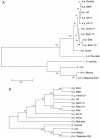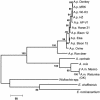Sequence analysis of the msp4 gene of Anaplasma phagocytophilum strains
- PMID: 15750101
- PMCID: PMC1081214
- DOI: 10.1128/JCM.43.3.1309-1317.2005
Sequence analysis of the msp4 gene of Anaplasma phagocytophilum strains
Abstract
The causative agent of human granulocytic ehrlichiosis was recently reclassified as Anaplasma phagocytophilum, unifying previously described bacteria that cause disease in humans, horses, dogs, and ruminants. For the characterization of genetic heterogeneity in this species, the homologue of Anaplasma marginale major surface protein 4 gene (msp4) was identified, and the coding region was PCR amplified and sequenced from a variety of sources, including 50 samples from the United States, Germany, Poland, Norway, Italy, and Switzerland and 4 samples of A. phagocytophilum-like organisms obtained from white-tailed deer in the United States. Sequence variation between strains of A. phagocytophilum (90 to 100% identity at the nucleotide level and 92 to 100% similarity at the protein level) was higher than in A. marginale. Phylogenetic analyses of msp4 sequences did not provide phylogeographic information but did differentiate strains of A. phagocytophilum obtained from ruminants from those obtained from humans, dogs, and horses. The sequence analysis of the recently discovered A. phagocytophilum msp2 gene corroborated these results. The results reported here suggest that although A. phagocytophilum-like organisms from white-tailed deer may be closely related to A. phagocytophilum, they could be more diverse. These results suggest that A. phagocytophilum strains from ruminants could share some common characteristics, including reservoirs and pathogenicity, which may be different from strains that infect humans.
Figures



References
-
- Allsopp, M. T., C. M. Dorfling, J. C. Maillard, A. Bensaid, D. T. Haydon, H. van Heerden, and B. A. Allsopp. 2001. Ehrlichia ruminantium major antigenic protein gene (map1) variants are not geographically constrained and show no evidence of having evolved under positive selection pressure. J. Clin. Microbiol. 39:4200-4203. - PMC - PubMed
-
- Asanovich, K. M., J. S. Bakken, J. E. Madigan, M. Aguero-Rosenfeld, G. P. Wormser, and J. S. Dumler. 1997. Antigenic diversity of granulocytic Ehrlichia isolates from humans in Wisconsin and New York and a horse in California. J. Infect. Dis. 176:1029-1034. - PubMed
-
- Barbet, A. F., P. F. Meeus, M. Belanger, M. V. Bowie, J. Yi, A. M. Lundgren, A. R. Alleman, S. J. Wong, F. K. Chu, U. G. Munderloh, and S. D. Jauron. 2003. Expression of multiple outer membrane protein sequence variants from a single genomic locus of Anaplasma phagocytophilum. Infect. Immun. 71:1706-1718. - PMC - PubMed
-
- Bowie, M. V., J. de la Fuente, K. M. Kocan, E. F. Blouin, and A. F. Barbet. 2002. Conservation of major surface protein 1 genes of the ehrlichial pathogen Anaplasma marginale during cyclic transmission between ticks and cattle. Gene 282:95-102. - PubMed
Publication types
MeSH terms
Substances
Associated data
- Actions
- Actions
- Actions
- Actions
- Actions
- Actions
- Actions
- Actions
- Actions
- Actions
- Actions
- Actions
- Actions
- Actions
LinkOut - more resources
Full Text Sources
Other Literature Sources
Molecular Biology Databases

